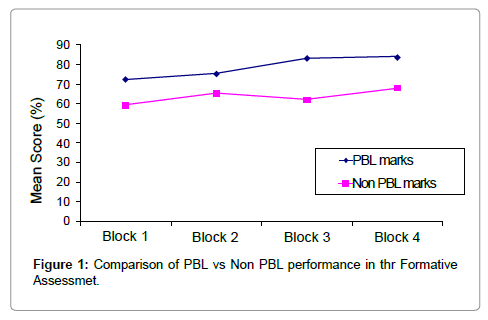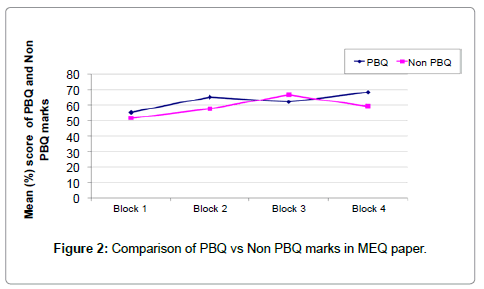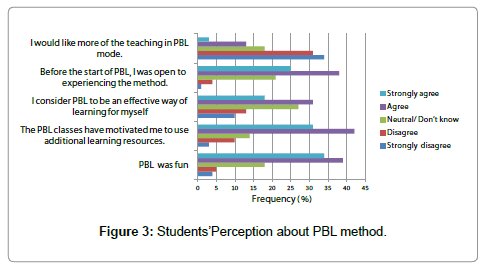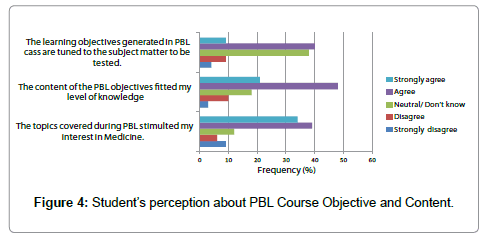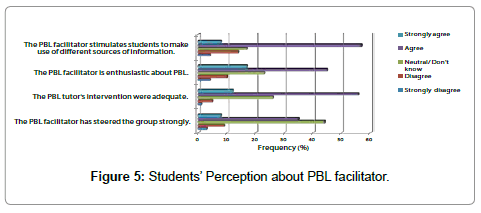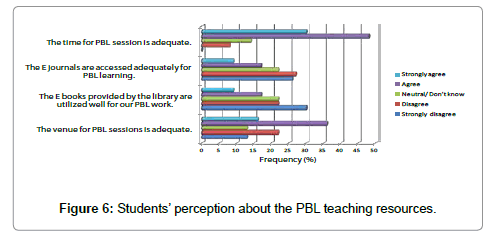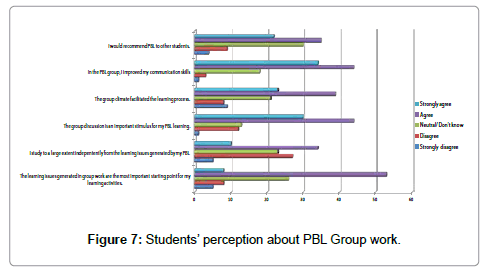Research Article Open Access
Early Introduction of Problem - Based Learning into the Integrated Curriculum of a Newly Established Medical School in Malaysia
Anita Devi K*, Pathak R, Chai JW, Noor H, Rohaini M, Samiah Yasmin AK and Atiya ASSEGi University, Selangor, Malaysia
- *Corresponding Author:
- Anita Devi K
Faculty of Medicine
SEGi University ,No. 9
Jalan Teknologi, Taman Sains Selangor
Kota Damansara, PJU5, 47810
Petaling Jaya, Selangor, Malaysia
E-mail: anitadevi@segi.edu.my
Received date: October 16, 2012; Accepted date: November 26, 2012; Published date: November 28, 2012
Citation: Anita Devi K, Pathak R, Chai JW, Noor H, Rohaini M, et al. (2012) Early Introduction of Problem – Based Learning into the Integrated Curriculum of a Newly Established Medical School in Malaysia. J Community Med Health Educ 2:189. doi:10.4172/2161-0711.1000189
Copyright: © 2012 Anita Devi K, et al. This is an open-access article distributed under the terms of the Creative Commons Attribution License, which permits unrestricted use, distribution, and reproduction in any medium, provided the original author and source are credited.
Visit for more related articles at Journal of Community Medicine & Health Education
Abstract
Introduction: Problem-Based Learning (PBL) is a student-centered instructional strategy in which students collaboratively solve problems and reflect on their experiences. At our newly established medical school’s Faculty of Medicine, PBL was introduced from the beginning of the medical programme with the aim of early introduction of clinical scenarios to foster critical thinking and group work. Methods: The students experienced four PBL cases, and each case consisted of two sessions. The students were assessed (by the facilitator) during each session as part of the formative assessment. At the end of each block, Problem- Based Questions (PBQs) were used as part of the Modified Essay Question (MEQ) paper. Student performance was analyzed based on (a) mean performance in PBL sessions during each block (as part of the continuous assessment), (b) PBQ marks (as part of end of block assessment), (c) student’s feedback (using questionnaire). Results and discussion: A comparative study of the performance in PBL sessions versus other formative assessment sessions showed a relatively better score in the PBL assessment. The End of Block examinations also reflected a better performance by the students in the PBQs as against the non-PBQ section. The questionnaire based analysis showed that the students favoured the PBL mode of learning. Though they appreciated and enjoyed the sessions, the students felt that lectures are equally or more important in disseminating basic sciences topics.
Keywords
Problem based learning; Early introduction; Year 1 medical students; Problem based questions; End of block exams; Continuous assessment; Formative assessment; Questionnaire; Student perception
Introduction
Problem-Based Learning (PBL) is a student-centered instructional strategy in which students collaboratively solve problems and reflect on their experiences [1].
Educational institutions need to adjust their strategies, from being based on the traditional lecture format, which is a form of passive learning to active learning methods. Specifically, active learning methods, such as Team-Based Learning (TBL) and Problem Based Learning (PBL), have been widely accepted as effective teaching methods and are increasingly popular in the modern curricula of medical schools for developing lifelong learning [2-4]. There is evidence that PBL is an instructional method which focuses on students learning through facilitated problem solving [5]. It also fosters self-directed learning and develops students’ lifelong learning characteristics [6]. The PBL approach has many advantages, such as: 1) it develops the personal competence in problem solving, critical reasoning [7], communication and social skills [8]; 2) it increases the learner’s effective to work in small groups; 3) it fosters self-directed and lifelong learning [2,4]; 4) PBL students become effective collaborators; and 5) it increases intrinsically motivated learning [9]. However, the main limitation of the PBL approach is that it is difficult to manage and implement in terms of time and resources [4]. PBL takes more time for teaching; it requires clear policies, strong support from top managers, and instructors who have the skills to facilitate PBL [7].
At the Faculty of Medicine in our university, PBL was introduced from the beginning of the medical programme with the aim of early introduction of clinical scenarios to foster critical thinking and group work.
Methodology
Problem based learning consisted of a tutor facilitated, problem based learning session in which a small, self directed group started with a brainstorming session. The students experienced four PBL cases in each block, and each case consisted of two sessions. In the first session, a problem was posed that reflected the theme for the block which challenged their knowledge and experience. Students were encouraged to define what they know, and then what they need to know in order to understand the problem. The justification for this is based in learning theory, which suggests that knowledge is remembered and recalled more effectively (in a “deeper” way) if it is based in the context in which it is going to be used in the future. For example, if joint anatomy is learnt in the context of a case history of a patient with osteoarthritis of the knee [10]. Learning goals were formulated by consensus and new information was learnt by self directed study. It ended with a group discussion and evaluation. The second session happened a week later where the information was consolidated after discussion. The students were assessed (by the facilitator) during each session as part of the formative assessment. At the end of each block, Problem-Based Questions (PBQs) were used as part of the Modified Essay Question (MEQ) paper. Two PBQs, each carrying 40 marks, were used which reflected the topics they had covered in the PBL sessions during the block. Student performance was analyzed based on (a) mean performance in PBL sessions during each block (as part of the continuous assessment), (b) PBQ marks (as part of end of block assessment), (c) student’s feed-back (using a questionnaire).
Results
A comparative study of the performance in PBL sessions versus other formative assessment sessions (such as weekly tests, practical marks and assignment scores) was done. The study reflected a relatively better score in the PBL assessments (Figure 1).
The evaluation using PBQ for the end of block exam showed a mean (average) score of 55% in Block 1, 66% in Block 2; 63% in Block 3 and 69% in Block 4. This was compared with the marks obtained from the non PBQ part of the same examination paper. The study showed that the marks contributed by the PBQ questions contributed a larger component as against the marks scored in the subject based questions (non-PBQ section).
The perception among students about PBL was assessed using a questionnaire based on the Likert scale [11]. The questions were classified into five groups namely, a) Perception about the PBL method (Figure 3), b) Perception about the course objective and content (Figure 4), c) Assessment about the facilitator (Figure 5), d) Perception about the usage of the available teaching resources (Figure 6) and e) Perception about PBL group work (Figure 7).
Discussion
The current study found that the mean performance of the students for the PBL sessions, as part of their continuous assessment steadily improved from block 1 to block 4. The End of Block examinations also reflected a better performance by the students in the PBQs as against the non-PBQ section in all the blocks except Block 3 (Figure 2).
The questionnaire based analysis showed that the students favored the PBL mode of learning. They felt motivated to use the resources available online and in the library rather than restrict themselves to lecturer notes alone. Regarding the content, they agreed that the case used in the block reflected the topics they were learning. Since it is an early introduction of PBL, care was taken to ensure that the cases given were testing their basic knowledge rather than too many clinical facts.
The students also felt that this mode of teaching stimulated their interest in learning the medical subjects. They seemed to understand the role of the basic medical sciences in understanding diseases and appreciated same. Though they appreciated and enjoyed the sessions, the students felt that lectures are equally or more important in disseminating basic sciences topics. They also felt that PBL encouraged more of group interaction rather than self learning. They also affirmed positively that PBL mode improved their communication skills and improved group dynamics.
Regarding the role of the PBL facilitator, the students felt that the intervention was adequate, though they felt that the facilitator could have intervened more and steered their discussion. This reflected the transition of students from a traditional schooling system to an integrated professional course where self-learning and group activities are encouraged.
The resources, though available in the form of textbooks, E books and journals were not adequately sourced; as most students were more comfortable with online sourcing of information. The venue provided was improved upon during the later part of the year since infrastructure development was still on-going and make-shift classes were used initially.
Conclusion
The study reflected a positive response for most of the parameters except for the usage of the E-learning resources. Alongside lecture mode of teaching, self-directed learning has to be introduced in the early stages of medical curriculum. The PBL approach is able to link the basic medical sciences topics with the clinical subjects and thereby gives a bird’s eye view to the importance of these subjects in the later part of their curriculum. In the early years of the medical course, PBL cases consist of clinical scenarios which focus more on the basic science topics are used. We conclude that early introduction of PBL in the medical curriculum improves the students’ cognitive domain as well as inculcates a positive attitude among them towards learning [12]. The factors related to learning styles and the influence of passive learning process eg: traditional lecture format, to which these students were used to should also be considered in future studies. A follow-up on the student’s performance and perceptions about PBL over the next four years must be done to document the effect of early introduction of PBL mode [13]. Being a new medical school, it will assist the Faculty in adapting the model for more effective learning.
References
- Hmelo-Silver CE, Duncan RG, Chinn CA (2006) Scaffolding and Achievement in Problem-Based and Inquiry Learning: A Response to Kirschner, Sweller, and Clark. Educ Psychol 42: 99–107.
- Holen A (2000) The PBL group: Self-reflections and feedback for improved learning and growth. Medical Teacher 22: 485-488.
- Clark MC, Nguyen HT, Bray C, Levine RE (2008) Team-based learning in an undergraduate nursing course. J Nurs Educ 47: 111-117.
- Michaelsen LK, Parmelee DX, McMahon KK, Levine RE (2008) Team-Based Learning for Health Professions Education, Stylus, VA: Stylus Publishing.
- Tan OS (2003) Problem-based Learning Innovation: Using problems to power learning in the twenty-first century, Singapore: Pearson.
- Holen A (1998) Advantages of problem-based learning. Tidsskr Nor Laegeforen 118: 2998.
- Kelly P, Haidet A, Schneider P, Searle V, Seidel N, et al. (2005) Teaching & Learning in Medicine. 17: 112- 118.
- Hmelo-Silver CE (2004) Problem-Based Learning: What and how do students learn. Educational Psychology Review 16.
- Barrow H, Keelson AC (1995) Problem-based Learning in Secondary Education and the Problem- Based Learning Institute (Monograph 1), Springfield, IL: Problem Based Learning Institute.
- Smits PB, Verbeek JH, de Buisonjé CD (2002) Problem based learning in continuing medical education: a review of controlled evaluation studies. BMJ 324: 153-156.
- Munshi FM, El Sayed A El Zayar, Dolmans DH (2008) Development and utility of a questionnaire to evaluvate the quality of PBL problems. SEAJME 2: 32 – 40.
- Koh GC, Khoo HE, Wong ML, Koh D (2008) The effect of problem-based learning during medical school on physician competency: a systematic review. CMAJ 178: 34-41.
- Paitoon Chuangchum, Thirdsak Pholchan, Tawesak Nopkesorn, Supasit Pannarunothai (2011) Effects of using an integrated team-based and problem based learning approach for developing lifelong learning characteristics of first year medical students. South‐East Asian Journal of Medical Education 2.
Relevant Topics
- Addiction
- Adolescence
- Children Care
- Communicable Diseases
- Community Occupational Medicine
- Disorders and Treatments
- Education
- Infections
- Mental Health Education
- Mortality Rate
- Nutrition Education
- Occupational Therapy Education
- Population Health
- Prevalence
- Sexual Violence
- Social & Preventive Medicine
- Women's Healthcare
Recommended Journals
Article Tools
Article Usage
- Total views: 14672
- [From(publication date):
November-2012 - Nov 07, 2025] - Breakdown by view type
- HTML page views : 10007
- PDF downloads : 4665

